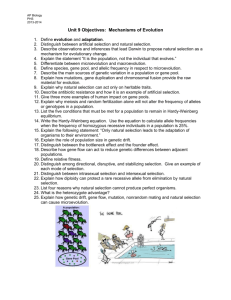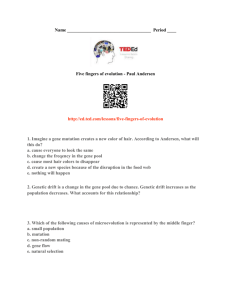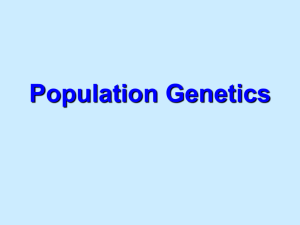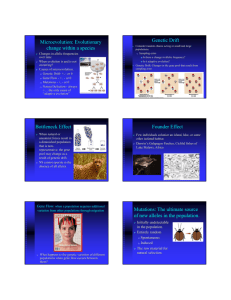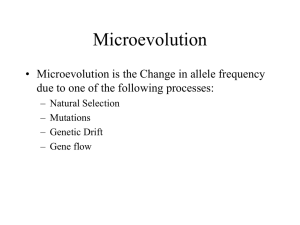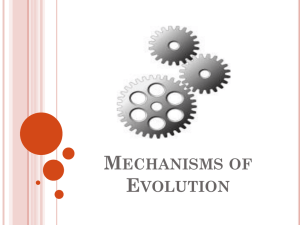Microevolution
advertisement
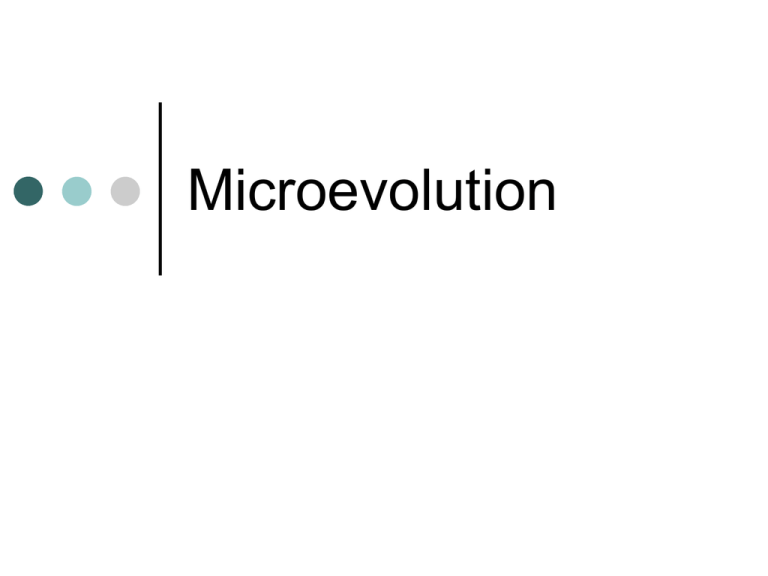
Microevolution Microevolution At the population level, evolution is a generation-to-generation change in a population’s frequency of alleles Even if the allele frequencies of only one gene (ie. flower color) are changing, the change in the gene pool is known as microevolution Causes of Microevolution There are 4 factors that cause microevolution: Genetic drift Natural selection Gene flow Mutation Genetic Drift Genetic drift is the chance fluctuation of a small population due to chance 700 heads, 300 tails vs. 7 heads, 3 tails Sampling error 2 major types of genetic drift Bottleneck effect Founder effect Bottleneck Effect Disasters reduce the size of a population dramatically, killing victims unselectively Result: The small surviving population is unlikely to be representative of the original population in its genetic makeup Some alleles may be lost Founder Effect The founder effect results when a few individuals from a larger population colonize a new, isolated habitat The new population is unlikely to be representative of the original population Natural Selection Populations consist of varied individuals, with some variations of individuals leaving more offspring than others Darwinian fitness: • the relative contribution an individual makes to the gene pool of the next generation • “survival of the fittest” Types of Natural Selection There are 3 major types of natural selection: Directional selection Diversifying/disruptive selection Stabilizing selection Directional Selection Shifts the frequency curve for variations in some phenotypic character in one direction or another From rare to average Example Average size of black bears in Europe increases in ice ages, decreases in warmer periods Diversifying/Disruptive Selection Favors variants of opposite extremes over intermediate individuals Stabilizing Selection Acts against extreme phenotypes Favors the more common intermediate variants Maintains the “status quo” Example: 3 – 4 kg. average for human births Gene Flow A population may gain or lose alleles by gene flow Gene flow is genetic exchange due to the migration of fertile individuals or gametes between populations Mutation A mutation is a change in an organism’s DNA Mutation at a given gene locus is very rare, but mutations at all gene loci can have a big impact Genetic Variation substrate Genetic variation is the on which natural selection works Quantitative characters: Vary along a continuum within a population Human height Discrete characters: “Either-or” Usually determined by a single gene locus Dimples/no dimples; ABO blood groups Polymorphism • When a population has two or more different “morphs” for a given trait • Freckles/no freckles Preserving Genetic Variation What prevents natural selection from reducing a population’s variation by eliminating unfavorable genotypes? Diploidy • Recessive alleles can “hide” in heterozygotes Balanced polymorphism • Heterozygote advantage (sickle cell) • Frequency-dependent selection • Survival and reproduction of any one morph declines if it becomes too common

